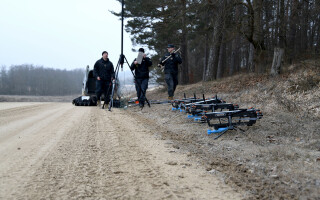Ground system procurement & modernization for FY 2017 DoD budget
NewsFebruary 27, 2016

WASHINGTON. Funding slated for major ground systems totals $9.8 billion under the Department of Defense Fiscal Year (FY) 2017 acquisition funding request, which totals $183.9 billion.
The funding request includes base funding and Overseas Contingency Operations (OCO) funding. The DoD’s “Program Acquisition Cost by Weapons System” booklet has $112.1 billion for procurement and $71.8 billion for Research, Development, Test, and Evaluation (RDT&E) of these weapon system programs. Of the $183.9 billion, $72.7 billion is for programs that have been designated as Major Defense Acquisition Programs (MDAPs) or Major Automated Information Systems MAIS. The Army continues to modernize and upgrade select MDAPs in FY 2017, including Stryker vehicles, Abrams Tanks, Bradley Fighting Vehicles, and Paladin 155mm Howitzers with vetronics and other modern technology. Program highlights are below. To read the entire booklet, click here.
JLTV
The Joint Light Tactical Vehicle (JLTV) is a joint program currently in development for the Army and Marine Corps, designed to replace the High Mobility Multipurpose Wheeled Vehicle (HMMWV), which is the current light tactical vehicle. There are two variants planned: Combat Support Vehicles (3,500 pounds) and Combat Tactical Vehicles (5,100 pounds). The FY 2017 program looks to fund the third and final year of Low Rate Initial Production (LRIP), procuring 2,020 trucks. It continues full up system level testing, including live fire testing. Total funding – procurement, research, and development – in the FY 2017 rises from $375 million in FY 2016 to $735 million. The prime contractor is Oshkosh Corp. in Oshkosh, Wisconsin.
M1A2 Abrams modification
The M1A2 Abrams is the Army’s main battle tank, which first entered service in 1980. It was produced from 1978 until 1994. Since then, the Army has modernized it with a series of upgrades to improve its capabilities, collectively known as the System Enhancement Package (SEP) and the Tank Urban Survival Kit (TUSK). Current modifications to the M1 Abrams include Vehicle Health Management and Power Train Improvement & Integration Optimization, which provide more reliability, durability and fuel efficiency. Survivability enhancements include armor upgrades. FY 2017 funding calls for development of mine blast survivability improvements and continues Engineering Change Proposal (ECP) IB (lethality improvements) development. It also calls for continuing to procure hardware for ECP 1A for installation during vehicle recapitalization in FY 2018, as well as many approved modifications to fielded M1A2 Abrams tanks, including the Ammunition Data Link (ADL) to enable firing of the Army’s new smart 120mm ammunition, and the Low Profile Commander’s Remote Operating Weapon Station (CROWS). Total funding – procurement, research, and development – in the FY 2017 rises from $509 million in FY 2016 to $559 million. The prime contractor is General Dynamics Corp. in Sterling Heights, Michigan.
Paladin
The M109 family of vehicles consists of the M109A6 Paladin 155mm Howitzer and the Field M992A2 Artillery Ammunition Support Vehicle (FAASV), an armored resupply vehicle. The Paladin Integrated Management (PIM) program addresses obsolescence, space, weight, and power concerns and Ensures sustainment of the M109 FOV through 2050. The PIM replaces the current M109A6 Paladin and M992A2 FAASV vehicles with a more robust platform, integrating the M2 Bradley common drive train and suspension components, according to the DoD. The PIM fills the capability gap created by cancellation of the Non-Line of Sight Cannon (NLOS-C) (a component of the Future Combat System program) in 2009. The PIM is in LRIP. The FY 2017 program funds support of final developmental testing and procures 48 PIM systems. Total funding – procurement, research, and development – in the FY 2017 rises from $426 million in FY 2016 to $636 million. The prime Contractor is BAE Systems in York, Pennsylvania.
Stryker
Stryker is a 19-ton wheeled armored vehicle that provides the Army with a family of ten different vehicles. There are two basic versions, which include the Infantry Carrier Vehicle (ICV) and the Mobile Gun System (MGS). There are eight different configurations, which include the Reconnaissance Vehicle (RV); Anti-Tank Guided Missile (ATGM); Nuclear, Biological, Chemical, and Radiological Vehicle (NBCRV); Medical Evacuation Vehicle (MEV); Commander’s Vehicle (CV); Fire Support Vehicle (FSV); Mortar Carrier (MC); and Engineer Squad Vehicle (ESV). Existing Strykers are being upgraded with a Double-V Hull (DVH) for improved protection against improvised explosive devices (IEDs), and a major engineering change proposal is being implemented to enhance mechanical and electrical power, upgrade the chassis and modernize the electronics network, according to the DoD. There are 81 vehicles that are receiving the Stryker Lethality Upgrade funded by the European Assurance Initiative (ERI) in FY 2016. The FY 2017 request funds completion of the fielding of the third DVH Stryker Brigade Combat Team (SBCT) and converts 123 Stryker vehicles to the DVH configuration to support the fourth DVH SBCT. Total funding – procurement, research, and development – in the FY 2017 drops from $1.181 billion in FY 2016 to $727 million. The prime contractor is General Dynamics Corp. in Sterling Heights, Michigan.
Amphibious Combat Vehicle
The Amphibious Combat Vehicle (ACV) is a Major Defense Acquisition Program and will replace the aging Amphibious Assault Vehicle. The FY 2017 request calls for funding manufacturing and delivery of 32 Engineering, Manufacturing and Development (EMD) test vehicles; and conducts contractor development test activities supporting the ACV Increment 1.1 program. Total funding – procurement, research, and development – in the FY 2017 drops from $212 million in FY 2016 to $159 million. The prime contractors are BAE Systems in York, Pennsylvania; and Science Applications International Corporation (SAIC) in McClean, Virginia.
For more FY 2017 MDAPs and MAIS coverage, click the following links:
Maritime systems and shipbuilding.





